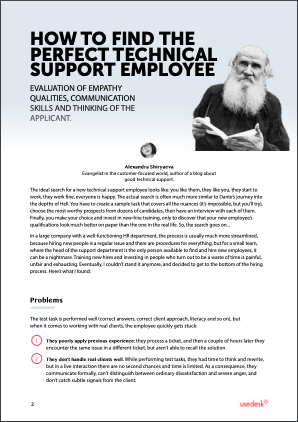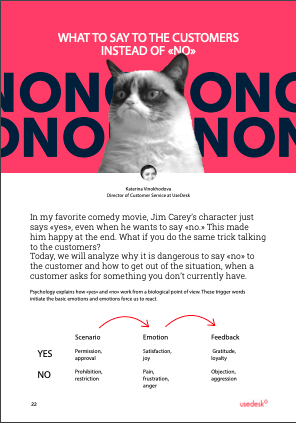Request a Demo
Send us a request for an online demonstration at the time that's convenient for you. We will give you an overview and answer any questions you may have about the system.
By clicking the button, you agree that you have read our Privacy Policy
HOW TO MEASURE THE EFFICIENCY OF THE CUSTOMER SUPPORT TEAM
PART 1: BASIC PRINCIPLES
PART 1: BASIC PRINCIPLES

Katerina Vinokhodova
Usedesk Co-Owner
"If you can't measure it, you can't manage it," Peter Drucker, the father of American management philosophy. Customer service is measured in multiple ways, considering the volume of received and missed calls, the duration of the conversation, amount of e-mails, the quality of feedback, and many other numbers that can be recorded and counted. Usedesk also helps to collect the statistical data.
However, the helpdesk does not specify which characteristic matters to your company. The customer support managers generate various reports volume, which is nearly the same as the total amount of the printed copies of the newspaper Pravda, but not all are useful. To ensure that your charts and diagrams do not turn into waste, we will help you identify what needs to be measured and produce a report using this data.
However, the helpdesk does not specify which characteristic matters to your company. The customer support managers generate various reports volume, which is nearly the same as the total amount of the printed copies of the newspaper Pravda, but not all are useful. To ensure that your charts and diagrams do not turn into waste, we will help you identify what needs to be measured and produce a report using this data.
What are Customer Support metrics?
To evaluate an employee's work or appraise team performance, you need to know how quickly they respond to the requests or how many letters they process per day. To identify the questions that the customers ask more often, you should count the number of the requests related to each "subject." Overall, you review the metrics at different levels depending on what you want to measure.

As a support team manager, you have access to all the data and thousands of other sources. The challenge is to select only the relevant ones and identify whom and how to present the data. Let's see what principles are used by the best support teams in the world.
1. Why do you run the reports?
The customer service's purpose is not to generate pretty reports and build colorful charts but to provide amazing customer service. Reports are needed to prove the amazingness of the service and demonstrate it in numbers. Depending on what your company considers an indicator of service quality, you apply relevant metrics.
Basecamp offers good customer service and quick response time as the features of the product. Cristina Aardsma, the head of customer support, believes that the most significant numbers are the first reply time and customer satisfaction rate.
Bill Bonds, Mailchimp, admits that his only headache was hiring enough support personnel to maintain quality of service during the period of rapid service expansion. "Everyone was focused on the growth, but I was repeating, "Hey, we are not done with hiring yet!" At that time, Bonds devoted all his time and efforts to distribute the volume of the tickets among the agents and keep a high level of customer satisfaction.
Basecamp offers good customer service and quick response time as the features of the product. Cristina Aardsma, the head of customer support, believes that the most significant numbers are the first reply time and customer satisfaction rate.
Bill Bonds, Mailchimp, admits that his only headache was hiring enough support personnel to maintain quality of service during the period of rapid service expansion. "Everyone was focused on the growth, but I was repeating, "Hey, we are not done with hiring yet!" At that time, Bonds devoted all his time and efforts to distribute the volume of the tickets among the agents and keep a high level of customer satisfaction.
Before you start counting something, ask yourself why you are doing this and what you want to see in the report?
2. Who are the Readers of the Report?
The most likely CEO will not be interested in reviewing the first line of the support's results. The content of the report depends on the intended audience.
Campaign Monitor enables running the customer service reports on three levels, and the content of each report is slightly different.
Campaign Monitor enables running the customer service reports on three levels, and the content of each report is slightly different.
- Agents send daily reports to the customer support manager via e-mail.
- The team manager places the monthly report on Wiki, where every employee can view it. These reports do not show the agents' individual results but report the team's results in total.
- The support team manager provides CEO with a high-level summary of statistics grouped in a couple of slides with brief comments on the current trends.
When drafting a report, think about the issues that concern the intended audience the most.
3. What is the Purpose of the Report?
After the presentation is given, people listening to you are yawning and asking – 'So what?' This is a fiasco. Ideally, it should be clear what needs to be done just from looking at your charts. You have a more favorable position here as you see the opportunities that your manager does not note.
Bounds from MailChimp focused on collecting the numbers showing that the team needs more people, and the report he presented contained the relevant indicators.
If your report is for the product manager to view, then point out the information on the feedback: how the customers use the products, the new product features proposed by the customers, and the issues with the product as reported by users. It allows looking at the product from a different angle and facilitates the changes for the better.
Bounds from MailChimp focused on collecting the numbers showing that the team needs more people, and the report he presented contained the relevant indicators.
If your report is for the product manager to view, then point out the information on the feedback: how the customers use the products, the new product features proposed by the customers, and the issues with the product as reported by users. It allows looking at the product from a different angle and facilitates the changes for the better.
Use your report to bring the decision-makers' attention to the problems you are looking to solve.
What is a Good Metric?
- Valuable. Tie the metrics to something that your company wants to achieve. If your goal is building a fast-responding support team, then the first reply time is an ideal metric to use, while the time to resolution is not that much important.
- Modifiable. Measure only the things you can change. Taylor Morgan recommends disregarding everything that does not change no matter what.
- Genuine. Reports should not mislead you. Be honest, even if it hurts.
- Contextual. Standalone numbers are meaningless; provide the context for them.
- Consistent. From a long-term perspective, the trends are more important than current data. 80% of happy customers - is it good or bad? Hard to say. However, if you see an increase from 70% to 80% over the month, that is definitely – wow, great news!
Present useful reports
Here is our monthly report. We received 20% fewer questions about setting up the triggers. By further developing the application, we have saved 12 hours of working time for the customer support team. This can be represented in dollar amounts as X dollars!
Look for correlations and links among the metrics. This may help to uncover deeper problems.
When the first reply to an e-mail reaches 4 hours, we see a corresponding drop in customer satisfaction.
We spend on billing questions about three times as much time as compared to other questions.
We spend on billing questions about three times as much time as compared to other questions.
Do not spend time generating reports that do not provoke any questions or induce any actions. Choose the right metrics and use them to tell how the customer support team contributes to the company's overall results. Next time, we will go into more details about the metrics, and we will think about whether the perfect numbers should be your goal.
Share with your colleagues:
Did you like this article?
Error get alias
We know a lot about customer service
Once every two weeks, we will send exciting and valuable materials about customer service - articles, cases, and system updates. Do you mind?







